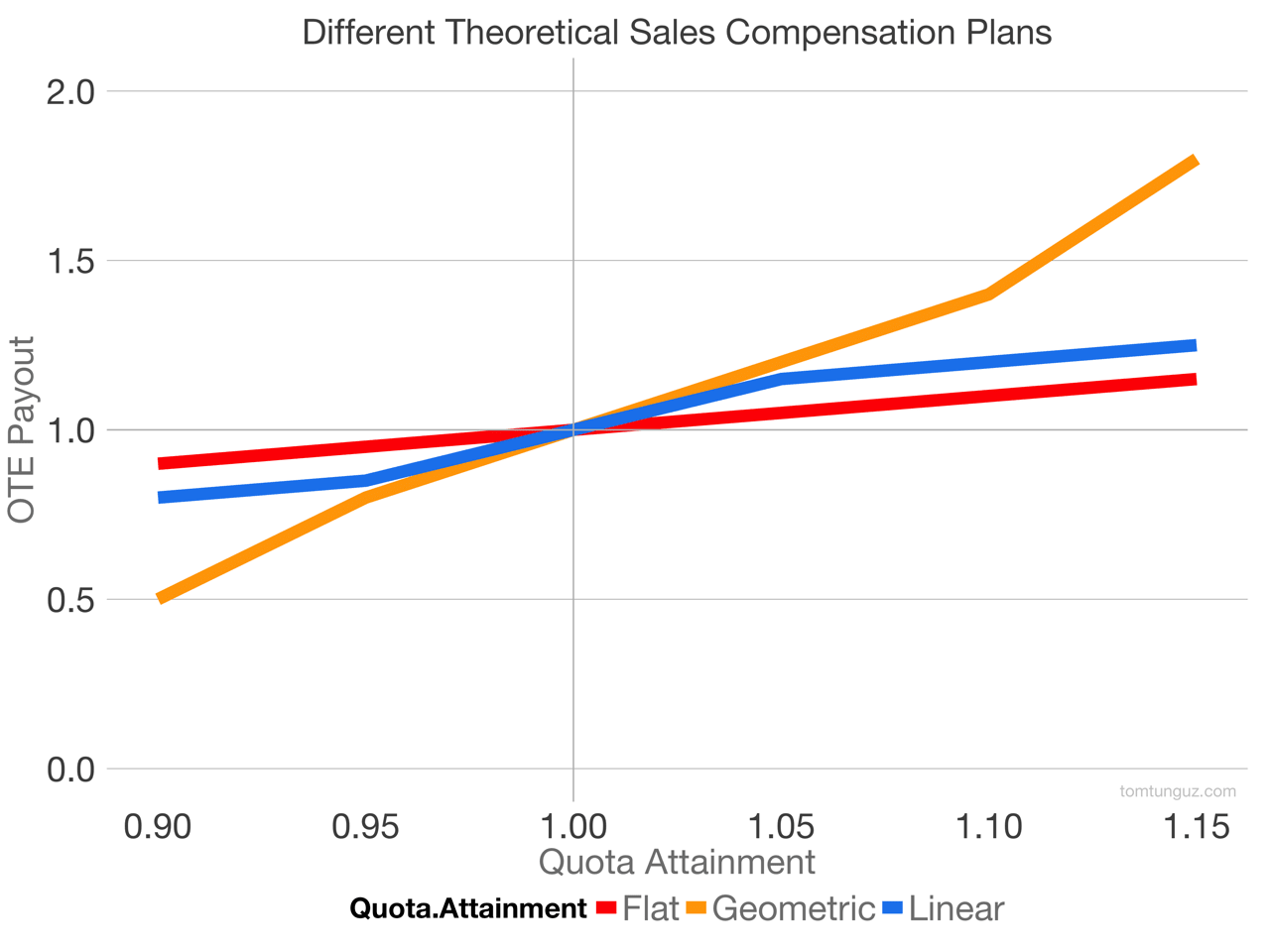4 minute read / Sep 4, 2017 /
The Theory and Data Underpinning Sales Commission Plans
Every startup’s sales commission plan is different. But it’s key to understand the theory and the benchmark data that governs the creation of sales commission plans to create a good one for your business.
Before we begin, let’s define a few terms. Sales compensation is communicated in OTE, On Target Earnings. OTE has two parts: salary/draw and commission. Salary is the annual amount paid to the employee irrespective of how much business he/she closes. Commission is the percentage of bookings awarded to the account executive in reward of the customers they close, adjusted by some multiplier. When you say OTE, you imply 100% quota attainment and the multiplier is one. In summary, OTE earnings is the amount of money the account executive will be paid if the AE attains the quota exactly.
The chart above demonstrates three different theoretical sales commission plans. The x-axis is quota attainment – the percentage of the booking goal the account executive attained. The y-axis indicates the commission multiplier. Two gray lines intersect at 100% quota attainment and a 1 OTE multiplier. That is OTE.
The flat strategy is the most basic. If the AE attains 90% quota, they are paid 90% of their commission. If the AE attains 110% quota, they are paid 110% of their commission.
The linear strategy is an offset. If AE attains 90% quota, they are paid 80% of their commission. If they attain 110% of quota, they are paid 120% commission. The formula for this one is: quota attainment - 10% if under quota; quota attainment + 10% if over quota.
The geometric strategy is even more extreme than the offset strategy but with the same idea. Massively overcompensate those who crush quota, and penalize those who don’t. At a 90% quota attainment, pay 50% commission. At 115% quota attainment, pay 180% commission.
These three strategies are quite different. When to use each one?
At the very early stages of a startup, sales hiring is critical. The management team may make a strategic decision to overcompensate early account executives for two reasons. First, to create stability within the account executive team and prevent competitive poaching. Second, to encourage the successful account executives to recruit their friends. Since they are making so much money, and the product is easy to sell, why wouldn’t they join?
The downside to paying much higher commissions is the cost to the business both in cash but also in efficiency metrics. The higher the cost of sales, the lower the sales efficiency. The greater the commissions, the greater the burn rate.
Let’s compare the costs of these three different strategies. If you would like to examine the math behind this table, see this Google Spreadsheet.
| Quota Attainment | 90% | 95% | 100% | 105% | 110% | 115% |
|---|---|---|---|---|---|---|
| Flat | 9% | 10% | 10% | 11% | 11% | 12% |
| Linear | 8% | 9% | 10% | 12% | 12% | 13% |
| Geometric | 5% | 8% | 10% | 12% | 14% | 18% |
At on target earnings, all of these sales commissions plans cost 10% of bookings. At the lower end, 90% of quota attainment, these plans span 5% to 9%. At the upper end, they spent 11.5% to 18%. What’s the right ballpark? Fortunately, the 2016 Pacific Crest Survey of private companies indicates that the median is 9% for inside sales teams and 10% for field teams.
So the geometric plan is the most expensive in the success case. To determine whether it’s worth it for your business, you would want to understand the implied impact to sales efficiency and ultimately cash flow dynamics. Can the business’s balance sheet sustain a commission payout twice the benchmark median?
When designing a sales compensation plan, it’s important to take into account the overall goals of the business including hiring an account executive retention, in addition to the desired efficiency of the sales organization. By calculating the commission rate and comparing it to benchmarks, your management team can determine exactly which trade-offs to make. Again, this is the most basic form of a sales commission plan, but it serves to explain the theory and the impact on other metrics.
